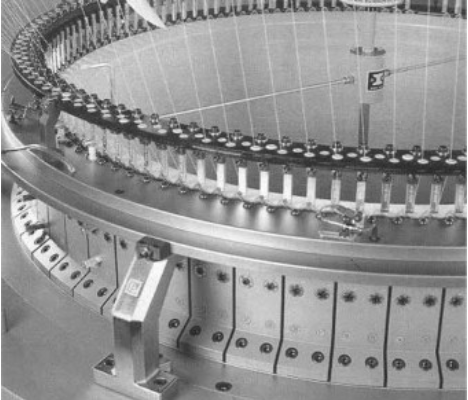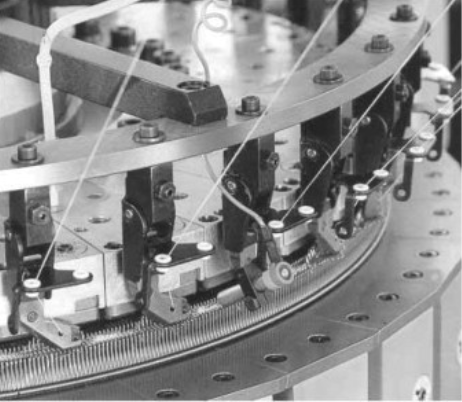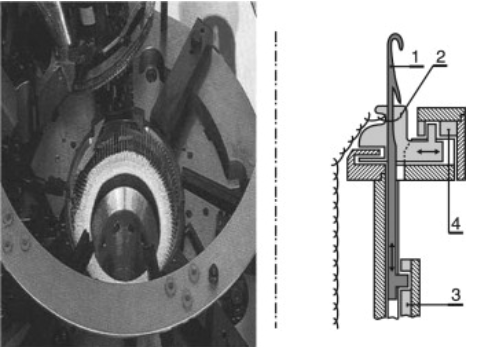Introduction
Until now, circular knitting machines have been designed and manufactured for mass production of knitted fabrics. The special properties of knitted fabrics, especially fine fabrics made by the circular knitting process, makes these types of fabric suitable for application in clothing, industrial textiles, medical and orthopedic garments, automotive textiles, hosiery,geotextiles, etc. The most important areas for discussion in circular knitting technology are increasing production efficiency and improving fabric quality as well as new trends in quality clothing, medical applications, electronic garments, fine fabrics, etc. Famous manufacturing companies have pursued developments in circular knitting machines in order to extend into new markets. Textile specialists in the knitting industry should be aware that tubular and seamless fabrics are highly suitable for various applications not only in textiles but also in medical, electronic, agriculture, civil and other fields.
Principles and classification of circular knitting machines
There are many types of circular knitting machine that produce long lengths of tubular fabric manufactured for specific end uses. Single jersey round knitting machine are equipped with a single ‘cylinder’ of needles that produces plain fabrics, about 30 inches in diameter. Wool production on Single jersey round knitting machine tends to be limited to 20 gauge or coarser, as these gauges can use two-fold wool yarns. The cylinder system of single jersey tubular knitting machine is demonstrated in Fig. 3.1. Another inherent feature of woollen single jersey fabrics is that the fabric edges tend to curl inwards. This is not a problem whilst the fabric is in tubular form but once cut open can create difficulties if the fabric is not finished correctly. Terry loop machines are the basis for fleece fabrics that are produced by knitting two yarns into the same stitch, one ground yarn and one loop yarn. These protruding loops are then brushed or raised during finishing, creating a fleece fabric. Sliver knitting machines are single jersey fabric tub knitting machine that have been adapted to trap a sliver of stable fiber into the knit structure.
Double jersey Knitting machines (Fig. 3.2) are single jersey knitting machines with a ‘dial’ that houses an extra set of needles positioned horizontally adjacent to the vertical cylinder needles. This extra set of needles allows the production of fabrics that are twice as thick as single jersey fabrics. Typical examples include interlock-based structures for underwear/base layer garments and 1 × 1 rib fabrics for leggings and outerwear products. Much finer yarns can be used, as single yarns do not present a problem for double jersey knitted fabrics.
The technical parameter is fundamental to the classification of lycra jersey circular knitting machine. The gauge is the spacing of the needles, and refers to the number of needles per inch. This unit of measure is indicated with a capital E.
The jersey circular knitting machine now available from different manufacturers are offered in a vast range of gauge sizes. For example, flat bed machines are available in gauge sizes from E3 to E18, and large-diameter circular machines from E4 to E36. The vast range of gauges meets all knitting needs. Obviously, the most common models are those with middle gauge sizes.
This parameter describes the size of the working area. On jersey circular knitting machine, the width is the operating length of beds as measured from the first to the last groove, and is normally expressed in centimeters. On lycra jersey circular knitting machine, the width is the bed diameter measured in inches. The diameter is measured on two opposite needles. Large diameter circular knitting machines can have a width of 60 inches; however, the most common width is 30 inches. Medium diameter circular knitting machines feature a width of about 15 inches, and the small diameter models are about 3 inches in width.
In knitting machine technology, the basic system is the set of mechanical components that move the needles and allow the formation of the loop. The output rate of a machine is determined by the number of systems it incorporates, as every system corresponds to a lifting or lowering movement of the needles, and therefore, to the formation of a course.
The system motions are called cams or triangles (lifting or lowering according to the resulting movement of the needles). The systems of flat bed machines are arranged on a machine component called the carriage. The carriage slides forward and backward on the bed in a reciprocating motion. The machine models currently available on the market feature between one and eight systems distributed and combined in various ways (number of carriages and number of systems per carriage).
Circular knitting machines rotate in a single direction, and the various systems are distributed along the bed circumference. By increasing the diameter of the machine, it is then possible to increase the number of systems and therefore the number of courses inserted per each revolution.
Today, Big circular knitting machines are available with a number of diameters and systems per inch. For example, simple constructions such as the jersey stitch can have up to 180 systems; however, the number of systems incorporated on large-diameter circular machines normally ranges from 42 to 84.
The yarn fed to the needles in order to form the fabric must be conveyed along a predetermined path from the spool to the knitting zone. The various motions along this path guide the yarn (thread guides), adjust the yarn tension (yarn tensing devices), and check for eventual yarn breaks.
The yarn is taken down from the spool arranged on a special holder, called a creel (if placed beside the machine), or a rack (if placed above it). The yarn is then guided into the knitting zone through the thread guide, which is typically a small plate with a steel eyelet for holding the yarn. In order to obtain particular designs such as intarsia and vanisé effects, the textile circle machine are equipped with special thread guides.
Hosiery knitting technology
For centuries, the production of hosiery was the main concern of the knitting industry. The prototype machines for warp, circular, flat and fully-fashioned knitting were conceived for knitting hosiery; however, hosiery production is centred almost exclusively on the use of small-diameter circular machines. The term ‘hosiery’ is used for clothes that mainly cover the lower extremities: legs and feet. There are fine products made of multifilament yarns on knitting machines with 24 to 40 needles per 25.4 mm, such as fine women’s stockings and tights, and coarse products made of spun yarns on knitting machines with 5 to 24 needles per 25.4 mm, such as socks, knee socks and coarse pantyhose.
Ladies’ fine-gauge seamless fabrics are knitted in a plain structure on single cylinder machines with holding-down sinkers. Men’s, ladies’ and children’s socks with a rib or purl structure are knitted on double-cylinder machines with a reciprocated heel and toe that are closed by linking. Either an anklet or an over-the-calf length stocking can be produced on a typical machine specification with 4-inch diameter and 168 needles. Currently, most seamless hosiery products are manufactured on circular knitting machines of small diameter, mostly between E3.5 and E5.0 or needle pitches between 76.2 and 147 mm.
Sports and casual socks in a plain base structure are now usually knitted on single-cylinder machines with holding-down sinkers. More formal simple rib socks may be knitted on cylinder and dual rib machines termed ‘true-rib’ machines. Figure 3.3 presents the dial system and knitting elements of true-rib machines.
Post time: Feb-04-2023



